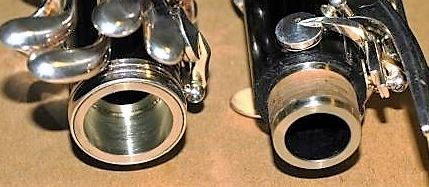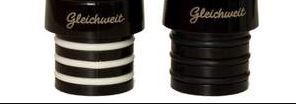-
Lohff & Pfeiffer
About Lohff & Pfeiffer
Iimprint
Contact
Newsletter
Location
L&P team
- Instruments
General
Trade options
About clarinet
Search specific instrument
Ab-clarinet
Eb-clarinet
D-clarinet
C-clarinet
Bb-clarinet
A-clarinet
Mozart basset-clarinet A
G-clarinet
Bassethorn F
Alto-clarinet Eb
Bass-clarinet
Contraalto Eb-clarinet
Contrabasse Bb-clarinet
German-Albert system Bb
Reform Boehm A & Bb
Peter Bastian Instruments
Plateau clarinets
Quartertone clarinet
- L&P Optimization
Optimization
Customization
Specialities
Special Keywork
- Accessories
General
Care products
For instruments
Reeds
Tools for reeds
Straps and hand rests
- Repair
Book time
About Repair
Maintenance
Plating-Surface treatment
Pads
Padding style
Cracks
Tone hole problems
Joints
- Tips & Advice
How to..
Videos
Worldwide external information
Problems & help
Education & learning

.Tenon joints
Tenon joints are the connectors between the different body parts. Their acoustical impact has often been overlooked. A good connection should:
1. Give an airtight seal between the joints, to prevent any leaks and lack of efficiency
2. Prevent the joints from wobbling, which could result in imprecise key connections.
3. Create a good mechanical connection between the joints. It is very helpful to increase the projection of the instrument.
They are available in different versions:
1. The traditional tenon for clarinets and bassoons has a tapered tenon and receiver in the instrument's material with cork as a connector. The different body parts need to be pushed together all the way to give a good connection. As soon as the parts are pulled out, the joints will wobble.
Wooden tenons can swell as soon as the wood becomes humid. To give the receivers more strength are they usually enhanced with metal rings. The receiving side has, therefore, no chance to expand, which will make it impossible to push the joints all the way together. In that case, the upper part, above the cork, will need to be diminished in diameter. As soon as the wood dries out, the joints might wobble. The best solution for that problem is a cylindrical metal joint connection, which can be added to every instrument.
2. Enhanced with a metal cap. Some models have a metal cap at the end of the tenons.
They protect the tenons from breaking and chipping. Acoustically we don't notice any difference.
3. The cylindrical tenon and receiver in the instrument's material with natural or artificial cork as a connector is a preferred style for recorders. The cylindrical tenon allows the player to pull out the joints to tune the instrument. Since all body parts are made out of the same material, swelling wood is usually no problem. Older or worn tenons can benefit from the epoxy-cork tenon. It is a less expensive solution against wobbling connections. read more

4. Cylindrical metal tenon and receiver with cork as a connector. These are by far the best and preferable tenons. The receiver, as well as tenon, are made in metal, which can be fitted very accurately. They allow to pull out the different joints to adjust the intonation. The swelling of the wood is no issue. They are used on oboes, English horns and Lohff & Pfeiffer offers them also on clarinets, basses, and basset horns. See also LP metal tenon system
.
5. Some mouthpiece makers use O-rings or rubber rings instead of the traditional cork. If the rubber contains solvent, it might tarnish the silver plated keys. This will have no impact on the sound.
6. For historic instruments or instruments made out of softwood, which change a lot under the influence of humidity changes, thread tenons are a good solution. They allow the player to add or remove some material depending on the humidity. It should be said that it takes some practice to get good results. It is very common among bassoon, recorder and historic instruments.
Help us to get better
Was this article helpful?
Comments, additions or questions are always welcome at: info@clarinet.dk(C) 2014 - by Lohff & Pfeiffer - Brøndbyvej 211 - 2625 Vallensbæk + 45 3535 8643 - SE DK 1895 7485 info@clarinet.dk - Instruments






